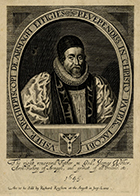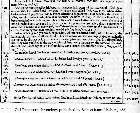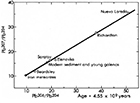About
Determining the age of the Earth historically was a complex endeavor, fraught with uncertainties. This website chronicles the numerous twists and turns in this story as leading naturalists, philosophers, and scientists sought to put an end to this age old question. Each section is devoted to either a period in time, an individual, or a technological advancement that guided this journey towards our present geologic time scale shown to the left.
- Doctrine - The Church's grasp on the age of the Earth.
- Geology - Relative dating methods for the age of the Earth.
- Thermodynamics - Elapsed time using cooling from a molten sphere.
- Radioactivity - Using isotopes to determines the age of the Earth.
Doctrine
The Christian Church's doctine on the age of the Earth relied upon biblical chrnonology until relatively recently. Prior to this, naturalists and philophers were weary of publishing ages of the Earth contrary to Church doctrine. Benoit De Maillet, a French diplomat born in the mid 1600's, wrote his estimates on the age of the Earth (2.5Ma) by way of fiction to avoid persecution. Using a conversation between a French missionary and an Indian philospher, De Maillet outlined his theory which was only published ten years after his death (Mathez, 2002).
The most well known biblical chronology is that of Bishop James Ussher, born in 1581 C.E. Ussher used astronomical cycles, historical accounts, and chronologies recorded in the Bible to assign corresponding dates. While Ussher's biblical chronology is perhaps the best known, chronologies existed as early as the 2nd century B.C.E with a date of Creation listed as 5529 B.C.E versus Ussher's date of 4004 B.C.E. (Dalrymple, 1991). Other prominent chronologies included those by John Lightfoot with the date of Creation as 3929 B.C.E., Johannes Kepler (3993 B.C.E.), and Sir Isaac Newton's estimate of 4000 B.C.E. (Usher Chronology)
The assumptions in these calculations are far and wide. One has to place a great deal of faith that records from thousands of years prior across multiple translations correspond to historical dates. The first serious assault on these estimates of the age of the Earth came from pioneering geologists during the Scottish Enlightenment.
Geology
Prior to the twentieth century, geology was restricted to relative dating methods when considering strata. Nicolas Steno laid the foundation for relative dating with the publication of Preliminary discourse to a dissertation on a solid body naturally contained within a solid, in 1669 (Reimold, 2007). Steno's ideas were later developed by James Hutton and would eventually be coined as the theory of Uniformitarianism. Hutton made two remarkable observations. The first was that there were exceedingly long periods of hiatus in the sedimentary record and the second was that igneous rocks were deposited in a molten state, allowing for a constant recycling of earth materials (Mathez, 2002). These observations lead to the development of deep-time, a concept that the Earth is exceedingly old popularized by Hutton's quote, "...we find no vestige of a beginning, no prospect of an end."
William Smith was an English surveyor charged with supervising the digging of the Somerset Canal during the late 1700's. Smith recognized that within fossil bearing sedimentary rocks at a given location, the same sequence of rock could be found miles elsewhere. Fossil correlation would become an essential tool for relative dating (McKenna, 2001).
Following in Hutton's footsteps was Charles Lyell. Lyell published Principles of Geology in 1830 which was the first manual of geology, highly influenced by Hutton's ideas. Charles Darwin read Lyell's Principles during his voyage on the HMS Beagle and came to a similar conclusion about the age of the Earth after estimating rates of erosion which would require hundreds of millions of years (Mathez, 2002). These estimates would soon be challenged by leading physicists of the 1800's.
William Smith was an English surveyor charged with supervising the digging of the Somerset Canal during the late 1700's. Smith recognized that within fossil bearing sedimentary rocks at a given location, the same sequence of rock could be found miles elsewhere. Fossil correlation would become an essential tool for relative dating (McKenna, 2001).
Following in Hutton's footsteps was Charles Lyell. Lyell published Principles of Geology in 1830 which was the first manual of geology, highly influenced by Hutton's ideas. Charles Darwin read Lyell's Principles during his voyage on the HMS Beagle and came to a similar conclusion about the age of the Earth after estimating rates of erosion which would require hundreds of millions of years (Mathez, 2002). These estimates would soon be challenged by leading physicists of the 1800's.
Thermodynamics
The idea that the Earth had cooled from a molten state was well known within intellectual circles by the 1700's as evidenced by writings from Sir Isaac Newton amongst others. Using this idea, a French naturalist and mathematician, The Comte de Buffon in 1779, created a small molten sphere with a similar composition to the Earth and measured the rate at which it cooled resulting in an age of the Earth of 75,000 years (England et al., 2007).
Lord Kelvin used a similar approach to the Comte of Buffon, although Kelvin used heat flow equations based on Joseph Fourier's work. Kelvin was able to calculate how long it would take a molten sphere to cool to the present day geothermal gradient. His age of the Earth ranged from 100Ma to 20Ma using a geothermal gradient of ~36°C/km. Kelvin made three assumptions. He assumed that the Earth was rigid, its physical properties were homogenous, and that no additional source of energy resided within the Earth (England et al., 2007).
Kelvin was wrong for two reasons. In Kelvin's model, conduction was the method of heat transfer. A former student of his, John Perry, critiqued Kelvin's model and proposed that convection as the method of heat transfer in the fluid interior of the earth which would result in a much higher conductivy value. Kelvin's second error was his ignorance of radioactivity. Kelvin was unaware that an additional heat source resulting from radioactive decay resided within the crust (England et al., 2007). This meant that if the geothermal gradient of the Earth had remained constant due to heat produced from radioactive decay, then the age of the Earth would be much greater than estimated by Kelvin. Radioactivity would soon prove to be a useful tool in pinning down the age of the Earth.
Radioactivity
Henri Becquerel recognized radioactivity in uranium in 1896, and the following year, the term radioactivity was coined by Marie Curie's discovery of radium (Lewis, 2002). Pierre Currie then recognized radioactive decay as a source of heat in 1903. Work by Ernest Rutherford in 1904 showed that the decay of elements produces alpha particles (helium ions). If the amount of helium within radioactive minerals could be measured, and the rate at which they are produced (half-life) was known, then the age of rocks could be calculated assuming none of the helium had leaked, which it consistently did (Mathez, 2002).
In 1911, Arthur Holmes established the Uranium-Lead system of dating which resulted in rocks measuring up to 3 billion years old. There were initial setbacks with this system however, when other scientists showed that lead could originate from other elements such as thorium, calling into question Holmes' age estimates. With a better understanding and the equipment necessary to measure systematic variations in lead isotopes during the 1940's, scientists crept closer to more accurate measurements, however they still lacked in knowing the original lead isotope ratios of the primeval Earth (Lewis, 2002).
This was resolved by Claire Patterson with the assumption that meteorites and the planet Earth formed at the same time. Lead isotope ratios from meteorites could then be used as a model for the primeval Earth, which resulted in a 4.5 billion year old Earth (Patterson, 1956).
References
Image 2 - http://www.britishmuseum.org/collectionimages/AN00406/AN00406723_001_l.jpg
Image 3 - http://www.geocities.ws/ResearchTriangle/System/8870/books/usher.GIF
Image 4 - http://media-3.web.britannica.com/eb-media/23/151223-004-F5C3C6F0.jpg
Image 5 - http://www.geology.ohio-state.edu/~vonfrese/gs100/lect29/xfig29_04.jpg
Image 6 - http://www.colorado.edu/geolsci/faculty/molnarpdf/2007GSAT.England.PerryKelvinBlownOpportunity.pdf
Image 7 - http://www.americanscientist.org/Libraries/images/20085291422116746-2007-07EnglandF2.jpg
Image 8 - http://hyperphysics.phy-astr.gsu.edu/hbase/nuclear/imgnuc/agemet.gif
Image 9 - http://hyperphysics.phy-astr.gsu.edu/hbase/nuclear/imgnuc/hlcurv2.gif
Image 10 - http://www.talkorigins.org/faqs/dalrymple/figure8.jpg
Image 11 (Background) - http://www.jpl.nasa.gov/spaceimages/images/largesize/PIA15808_hires.jpg
(4): 342-349. doi: 10.1511/2007.66.3755
England, Philip C., Molnar, P., and Righter, F. (2007). “John Perry’s neglected critique of Kelvin’s age of the Earth: A(missed opportunity in geodynamics”. GSA Today 17 (1): 4-9. doi: 10.1130/GSAT01701A.1.
(New York Times Company, 05 Aug. 2001. Web. 20 Apr. 2015.
Patterson, C. (1956). Age of meteorites and the earth. Geochimica et Cosmochimica Acta, 10(4), 230-237. Reimold, W. U. (2007). Revolutions in the Earth Sciences: Continental Drift, Impact and other Catastrophes. South African(Journal of Geology, 110(1), 1-46. doi: 10.2113/gssajg.110.1.1
"Ussher Chronology." Wikipedia. Wikimedia Foundation, n.d. Web. 20 Apr. 2015.











